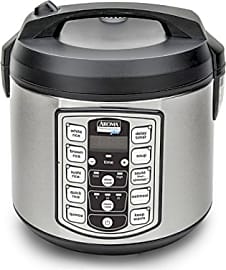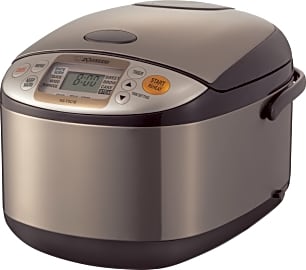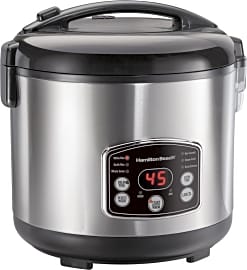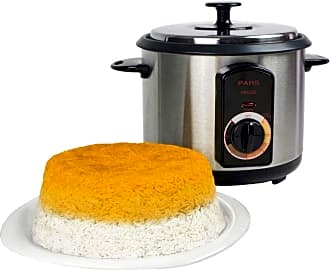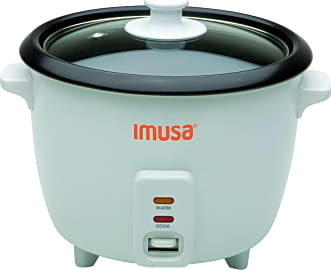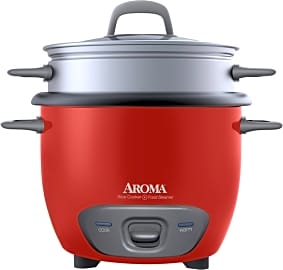The 10 Best Rice Cookers

This wiki has been updated 43 times since it was first published in May of 2015. While Japanese chefs spend their entire lives perfecting its preparation, making a quality batch of rice at home will take you well under an hour, thanks to the marvels of modern technology. Not only will these cookers produce fluffy and moist results, many of them can also prepare accompanying foods at the same time, and some even have preprogrammed settings for different types of grain. When users buy our independently chosen editorial picks, we may earn commissions to help fund the Wiki.
Editor's Notes
May 21, 2019:
The super-smart Zojirushi Neuro Fuzzy makes cooking rice virtually foolproof, with a microcomputer that adjusts the settings to maintain the proper temperature and moisture level. Its digital display has a built-in timer, and the fold-down handle makes it easy to pick up and move. It does take a little longer to cook than some others, but the end result is well worth it. If you want something speedier, though, the Cuckoo M1059F offers pressure and turbo cook modes, along with a convenient automatic steam clean function. The Tiger JKT-S and Tiger JBV-A10U both have a "synchro cooking" mode that allows you to cook meats and vegetables along with your rice in a tray that's specifically designed to prevent the flavors from affecting each other.
If you just want a simple machine to cook rice without all the bells and whistles, both the Aroma 6-Cup and the Imusa Electric offer easy one-button operation, but since they don't have the temperature control features of higher-end models, they tend not to cook as evenly and don't always work well for brown rice and whole grains.
More Than Just A Hot Pot
They can tell when the internal temperature has reached a boiling point and immediately reduce the heat to bring the rice and water back down to a simmer.
I never questioned a rice cooker when I was growing up. Even into my college days, if I put any thought into it–which I doubt I did–I'm sure I just thought that the rice cooker turned off after a preset amount of time relative to an average rice recipe.
It turns out there was a lot more going on, even in those rudimentary rice cookers, than I could have guessed.
At its most basic, the rice cooker is a metal or ceramic pan inside an outer pot with an electric heating element under the bottom of it. That heat cooks the rice. Pretty simple, right?
Well, from there we get to a number of questions. For example, rice is supposed to come to a boil and then drop to a simmer. How does the cooker manage that automatically? And how does it know when the rice is ready?
Most modern rice cookers, in addition to the simple components listed above, also have sensors for both heat and residual steam.
They can tell when the internal temperature has reached a boiling point and immediately reduce the heat to bring the rice and water back down to a simmer. That simmer holds in place until the steam sensor stops picking up a heavy amount of the evaporated water, at which point your rice is done.
This is pretty important, since different rices take different amounts of time and water to cook, and most people ignore those differences and stick to the old 2-1 water-rice ratio. I'm one of those people, and I can attest that a smarter rice cooker, for most folks, is a good thing.
You Can Never Have Too Much Rice
In 2015, human beings consumed 484,592,000 metric tons of rice, give or take a grain.
I'm going to let that sink in with you for a minute. Go ahead. Try to picture that much rice. The image doesn't appear, does it? It's like the economic values placed on international bailouts or the number of stars in our galaxy; they hardly seem like real quantifiable amounts.
This is what's known as a cognitive limitation, which is basically an individual's point of no numerical return.
It's like the economic values placed on international bailouts or the number of stars in our galaxy; they hardly seem like real quantifiable amounts.
Fortunately for our shopping purposes here today, none of these rice cookers can approach the average human cognitive limits. They mostly make rice by the cup.
It is important, however, that you have some handle on the quantity of rice you intend to make over the days, and months, and years.
If you're cutting carbs and focusing on green leafy vegetables (because we all should be), you might not want to make yourself 12 cups of rice with each pass. I know that I couldn't withstand the temptation of all those sweet, starchy simple carbs.
For me, smaller rice cookers have the edge in self-control. In addition to limiting the amount of rice you can make in a session, they also limit the size of the cheesecake you can make in your rice cooker.
If you have a big family to feed, or you're a sumo wrestler in training, you should get the biggest rice cooker on the planet. Maybe get two of them.
Capacity is the first place from which you'll want to evaluate each cooker. Worry about the features after that, and you'll be happy with whatever decision you come to.
The Rice Cooker: A Shocking Development
In the lead up to the second world war, while Japan was at the height of its expansion into Chinese and Mongolian territories, engineers were hard at work to develop ways to keep their soldiers fit and fed on the battlefield.
One of these inventions was a portable, electric rice cooker that was installed in a kind of roving automotive kitchen.
One of these inventions was a portable, electric rice cooker that was installed in a kind of roving automotive kitchen.
It had wooden walls and an electric current running through a coil at the bottom of the bucket. As the water in which the rice cooked reduced, so too did the conductivity and the cooker's heat output. As a result, once the bulk of the water had been absorbed into the rice, the cooker entered a "keep warm" setting automatically.
The big problem with this design? It electrocuted a lot of people, what with that current running through the cooking rice and all.
By the end of the war, Mitsubishi made a commercial version available to the public with an aluminum pan, though it had no automatic functions, so it required constant observation in the kitchen.
In the 70 years since its introduction to the marketplace, rice cookers have become more sensitive and capable, safer and more durable than their predecessors by leaps and bounds.



